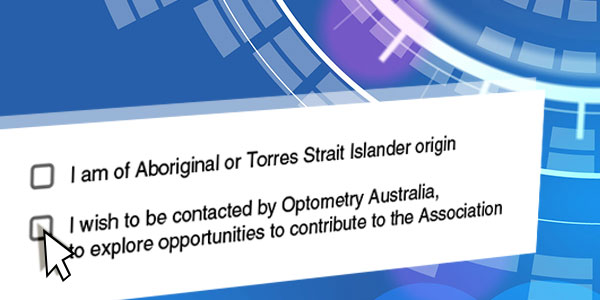1:30min
 By Helen Carter
By Helen Carter
Journalist
Optometry Australia is encouraging members to identify if they are of Aboriginal and/or Torres Strait Islander origin at membership renewal time. This will ultimately help improve care for Indigenous people.
The Association will ask two questions in check boxes relating to Aboriginal and/or Torres Strait Islander origin: Are you of Aboriginal or Torres Strait Islander origin, and, if so; Do you wish to be contacted by Optometry Australia to explore opportunities to contribute to the Association?
Membership renewal communications will be sent out in the coming week.
Indigenous eye health advocate and optometrist, Mitchell Anjou AM said it was important to support the identification of Aboriginal and Torres Strait Islander practitioners because these colleagues are the most knowledgeable and best positioned to help improve eye care service to Aboriginal and Torres Strait Islander people, having both an Aboriginal and Torres Strait Islander background and optometry expertise.
‘Many individuals, agencies and organisations continue to work on improving eye care for Aboriginal and Torres Strait Islander people and a key element of that is asking whether we have the input of Aboriginal and Torres Strait Islander people to better inform the improvement of those services,’ he said.
‘Critical to that is that some of our profession are of an Aboriginal and/or Torres Strait Islander background. This valuable combined understanding of culture, community and optometry can provide the greatest insight into how we might further improve Aboriginal and Torres Strait Islander eye care.’
Mr Anjou, who is Deputy Director of the University of Melbourne’s Indigenous Eye Health Unit, and a long-standing member of Optometry Australia’s Aboriginal and Torres Strait Islander Eye Health Advisory Group said workforce equity was another important issue.
‘There are very few optometrists who identify as Aboriginal and/or Torres Strait Islander,’ he said. ‘While three per cent of the Australian population is Aboriginal and/or Torres Strait Islander, only 0.1 per cent of optometrists identify as Aboriginal and/or Torres Strait Islander.
‘At last count (Optometry Board of Australia 2018), there were seven Aboriginal and/or Torres Strait Islander optometrists practising in Australia, but if three per cent of optometrists were Aboriginal and Torres Strait Islander, there would be 165 Aboriginal and Torres Strait Islander optometrists!’
He said a stronger Aboriginal and Torres Strait Islander optometry workforce would help deliver on a number of goals including improving Aboriginal and Torres Strait Islander eye health, more equitable eye health outcomes, a stronger Aboriginal and Torres Strait Islander health workforce and a culturally safer health system.
‘I encourage my colleagues to identify, and at the same time the optometry schools need to look at their recruitment, support and retention strategies for Aboriginal and Torres Strait Islander students,’ he said.
Contribution laid solid foundations
Manager of the Indigenous Australia Program at The Fred Hollows Foundation, Shaun Tatipata from Darwin is a descendant of the Wuthathi people and identifies as an Aboriginal Australian. He has worked in Aboriginal and Torres Strait Islander health for over 18 years.
‘To achieve a culturally safe and responsive eye care workforce we must have a greater representation of Aboriginal and Torres Strait Islander people across all our professions,’ he told Optometry Australia.
’The contribution that my First Nations brothers and sisters are already making as optometrists has laid solid foundations and we need to acknowledge this and continue to build on it.
‘By identifying, we can better gauge how successful we have been as a sector to encourage and support Aboriginal and Torres Strait Islander people to train as optometrists and then seek to strengthen these pathways for the next generation.’
Optometry Australia’s Policy and Advocacy Manager Sarah Davies said the Association was eager to engage with members who would be keen to support our policy development and advocacy work in relation to closing the gap in eye health.
‘As the national peak body for the optometry profession in Australia, Optometry Australia is committed to national efforts to close the gap in Aboriginal and Torres Strait Islander eye health,’ Ms Davies said.
‘In particular, we seek to ensure effective representation of Aboriginal and Torres Strait Islander optometrists within the profession, including establishing effective pathways for Aboriginal and Torres Strait Islander optometrists to contribute to Optometry Australia as members of our advisory groups and governance structures.’
She said the organisation wanted to ensure that work practices and the profession were culturally safe for Aboriginal and Torres Strait Islander optometrists. Partnering and supporting Aboriginal organisations, representation on advisory groups and Optometry Australia’s development of a Reconciliation Action Plan all helped to deepen trust.
Tagged as: Indigenous eye health